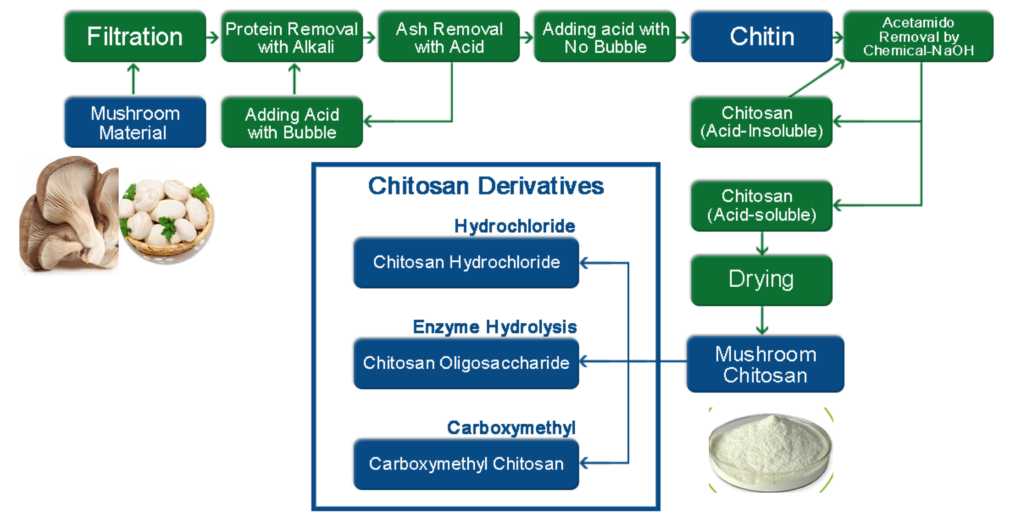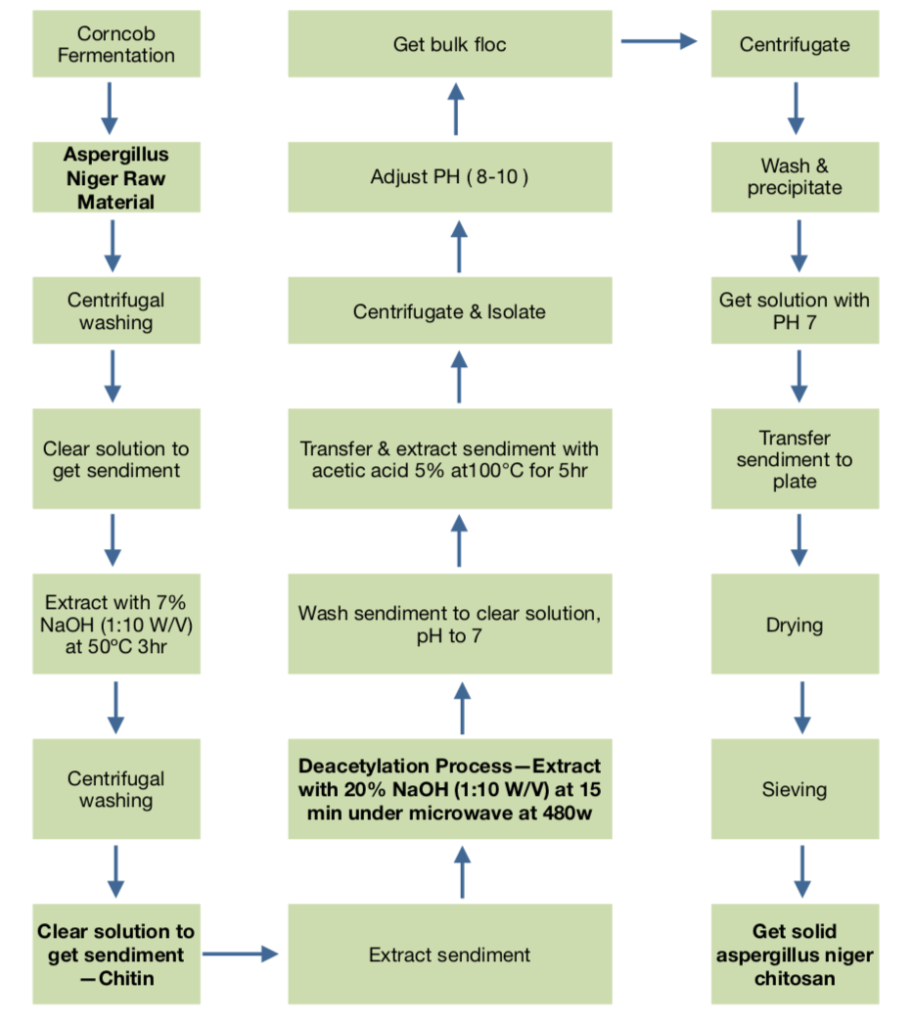1. What is vegetal chitosan?
Chitosan is a linear polysaccharide composed of randomly distributed β-(1→4)-linked D-glucosamine (deacetylated unit) and N-acetyl-D-glucosamine (acetylated unit).

Chitosan, sometimes known as deacetylated chitin, is a natural polycationic linear polysaccharide derived from partial deacetylation of chitin. Chitin is the structural element in the exoskeleton of insects, crustaceans (mainly shrimps and crabs shell), and cell walls of fungi (oyster mushroom, agaricus bisprous and aspergillus niger), and also is the second most abundant natural polysaccharide after cellulose.

Chitosan, a natural polysaccharide prepared of fungal origin, is initially extracted and purified from reliable and abundant food or biotechnological fungal sources such as Agaricus bisporus or Aspergillus niger.
Chitosan is obtained by hydrolysis of a chitin-rich extract. Chitin is a polysaccharide composed of several N-acetyl-D-glucosamine units interconnected by ß→(1.4) type linkages.
Chitosan is composed of glucosamine sugar units (deacetylated units) and N-acetyl-D-glucosamine units (acetylated units) interconnected by ß→(1.4) type linkages.

Chitosan has been widely used in various fields, including wine, pharmaceuticals, dietary supplement, medicine, agriculture, and food industries, due to its biocompatibility, biodegradability, and non-toxicity. In recent years, researchers have investigated the use of vegetal chitosan, which is derived from fungal or plant sources, as a sustainable alternative for use in wine applications.
2. What are the advantages of vegetal chitosan?
Vegetal chitosan, also known as fungal chitosan or mycelium chitosan, is a type of chitosan derived from the cell walls of fungi (mushroom and aspergillu niger). It has several advantages over traditional chitosan derived from shellfish, including:

- 1. Vegan and vegetarian-friendly: Vegetal chitosan is an excellent alternative for individuals who avoid animal-based products, such as those who follow a vegan or vegetarian lifestyle.
- 2. Allergen-free: Traditional chitosan is derived from shellfish, which can cause allergic reactions in some people. Vegetal chitosan does not contain any shellfish-derived ingredients, making it an allergen-free option.
- 3. Purer: Vegetal chitosan is often considered to be purer than traditional chitosan because it is derived from a single source, whereas traditional chitosan can be contaminated with other shellfish-related substances.
- 4. Better solubility: Vegetal chitosan is more soluble than traditional chitosan, which makes it easier to incorporate into various applications such as cosmetics, pharmaceuticals, wine and food.
- 5. Improved bioavailability: Some studies have suggested that vegetal chitosan has a higher bioavailability compared to traditional chitosan, which means that it can be absorbed and utilized more effectively by the body.
Overall, vegetal chitosan offers several advantages over traditional chitosan, making it an attractive alternative for individuals and industries looking for a vegan, allergen-free, and more effective chitosan source.
3. What are the benefits of vegetal chitosan in cosmetic application?
In the ever-evolving world of cosmetic science, the quest for natural and effective ingredients is perpetual. Among these, vegetal chitosan emerges as a remarkable and sustainable option, offering an array of benefits for skin care and beauty products. This article delves into the properties of vegetal chitosan, its advantages in cosmetic formulations, and the impact it has on the industry and consumers.
Chitosan, traditionally derived from the shells of crustaceans, has a vegetal counterpart obtained from fungal sources: mushroom and aspergillus niger. This biopolymer is known for its biocompatibility, biodegradability, and non-toxicity, making it a favorable ingredient in cosmetics.
Key Benefits in Cosmetics:
1. Moisturization and Skin Barrier Enhancement: Vegetal chitosan is an excellent natural moisturizer. Its hygroscopic nature allows it to retain moisture, thereby maintaining the skin’s hydration levels. Additionally, it forms a breathable film on the skin, enhancing its barrier function and protecting it from environmental stressors.

2. Anti-Aging Properties: Its ability to promote collagen synthesis makes vegetal chitosan a valuable component in anti-aging products. By fostering skin elasticity and reducing the appearance of fine lines and wrinkles, it helps in maintaining youthful skin.

3. Antimicrobial and Healing Qualities: The inherent antimicrobial properties of vegetal chitosan make it beneficial in acne treatments and products aimed at skin prone to infections. It also accelerates wound healing, making it suitable for use in post-procedural skin care.

4. Enhancing Product Stability and Efficacy: In formulations, vegetal chitosan acts as a natural preservative and stabilizer, extending the shelf-life of products. Its ability to form stable emulsions enhances the texture and application of cosmetics.
5. Sustainability and Eco-Friendliness: Being plant-based, vegetal chitosan is a renewable resource. Its use reflects a commitment to sustainable practices in the cosmetic industry, catering to the growing demand for eco-friendly products.

Market Implications and Consumer Perception:
The inclusion of vegetal chitosan in cosmetic products aligns with the increasing consumer preference for natural and sustainable beauty solutions. Its multifunctional properties not only elevate product performance but also resonate with the ethos of environmentally conscious consumers.
4. What is the optimal concentration of vegetal chitosan for use in cosmetic formulations?
The dosage of vegetal chitosan in cosmetics varies depending on the type of product and the desired effect. Generally, chitosan is used in concentrations ranging from 0.1% to 2% in cosmetic formulations. Here are some guidelines:
1. Moisturizing and Anti-Aging Products: For creams and lotions aimed at moisturizing or anti-aging, concentrations typically range from 0.5% to 2%. At these levels, chitosan can effectively help in moisture retention and improve skin elasticity.

2. Acne Treatments and Antimicrobial Applications: In products targeting acne treatment or requiring antimicrobial properties, chitosan is often used in lower concentrations, around 0.1% to 1%. Even at these levels, it can effectively reduce bacterial growth and aid in skin healing.

3. Hair Care Products: In shampoos and conditioners, chitosan is typically used at concentrations of 0.1% to 1%. It helps in improving hair texture, providing strength, and enhancing moisture retention.

4. Makeup Products: In makeup products like foundations or mascaras, chitosan concentrations usually range from 0.5% to 1.5%, contributing to the product’s stability, adherence, and moisture retention properties.

5. Stabilizers and Preservatives: As a stabilizing or preservative agent in various cosmetic formulations, chitosan can be used at levels of 0.1% to 2%, depending on the product’s formulation and stability requirements.

6. Fragrance and essential oils: Vegetal chitosan, derived from sources like fungi, can offer several benefits when used in fragrances and essential oils:
- Enhanced Stability: Chitosan can help stabilize the volatile compounds in fragrances and essential oils, prolonging the shelf-life and maintaining the integrity of the scents over time.
- Controlled Release: It can be used to create microcapsules that encapsulate fragrance molecules, allowing for a controlled and prolonged release of scent.
- Emulsification Properties: In products that combine oil and water phases, chitosan can act as an emulsifier, ensuring that the essential oils are evenly distributed throughout the product without separating.
- Increased Solubility: Some fragrance compounds are not very soluble in water-based products. Chitosan can increase the solubility of these compounds, allowing for a more uniform scent profile.
The dosage of vegetal chitosan in fragrances and essential oils can vary significantly based on the desired outcome and the specific formulation of the product. However, generally, chitosan is used at relatively low concentrations in such applications, often ranging from 0.1% to 1%.
In fragrance encapsulation, for example, the amount of chitosan used will depend on the method of microencapsulation and the required release profile. For stabilization and solubilization in perfumes or essential oil mixtures, the dosage would depend on the volatility of the oil and the type of product being formulated.

It’s important to note that the optimal dosage can vary based on the specific type of vegetal chitosan used, as different grades and molecular weights can have different effects. Additionally, compatibility with other ingredients in the formulation and the desired product viscosity also play a role in determining the appropriate concentration. Cosmetics manufacturers typically conduct extensive formulation testing to determine the optimal dosage for their specific product needs.
5. What is the flowchart of vegetal chitosan processing?
The production process of plant chitosan is mainly obtained by extracting raw materials (mushrooms, Aspergillus niger), deproteinizing with dilute acid or alkali, deacetylating, drying, etc.
Here is a simplified flowchart of the production process of vegetal chitosan for your reference.


6. In summary of vegetal chitosan in cosmetic application:
Vegetal chitosan stands as a testament to the potential of natural ingredients in revolutionizing cosmetic formulations. Its multifaceted benefits, ranging from skin health enhancement to sustainability, position it as a valuable addition to the repertoire of cosmetic ingredients. As the industry continues to embrace green science, vegetal chitosan is poised to play a significant role in the development of innovative and conscientious beauty products.

